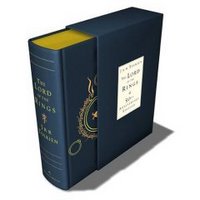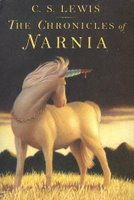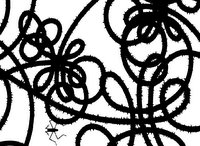"The Arts", the Gospel and Christmas Presents
Woah!
a furiously working mind and an excited sleepless night thinking of evangelistic Christmas pressies, Christmas being the one time during the year that you can mention/write about Jesus without being shown the door. An opportunity not to be missed!
But what evangelistic Christmas presents to give?
In many circles, original artwork (drawing, painting, sculpture, short stories, short films) is always welcome (and certainly far more welcome than those fundamentalist evangelistic books). But how can those pieces of art present the gospel clearly and faithfully?
It's one thing that your personal "religious" beliefs are inevitably reflected in your art, like what some read as the themes of recovery, escape, consolation, salvation and redemption in the Catholic JRR Tolkien's "Lord of the Rings" and "The Silmarillion".
 It's another thing to set out with the goal of telling the gospel clearly and faithfully in art:
It's another thing to set out with the goal of telling the gospel clearly and faithfully in art:
Perhaps also, using artistic talents to create a rocking good atmosphere for Christmas party with music, dancing, great food and wine and a cutting talk on why we're celebrating the supposed birth day of a runt born 2000 years ago, might be a spiffy idea.
But what evangelistic Christmas presents to give?
In many circles, original artwork (drawing, painting, sculpture, short stories, short films) is always welcome (and certainly far more welcome than those fundamentalist evangelistic books). But how can those pieces of art present the gospel clearly and faithfully?
It's one thing that your personal "religious" beliefs are inevitably reflected in your art, like what some read as the themes of recovery, escape, consolation, salvation and redemption in the Catholic JRR Tolkien's "Lord of the Rings" and "The Silmarillion".
 It's another thing to set out with the goal of telling the gospel clearly and faithfully in art:
It's another thing to set out with the goal of telling the gospel clearly and faithfully in art:- in the first place, it is sometimes argued that the gospel does not make for good art, for the gospel is only one story with one moral: acknowledge that you are a sinner that has rebelled against God, trust that Jesus has taken on your punishment for your rebellion for you and that you have been and will be saved from God's wrath. Same story every year = very boring, goes the argument; and then
- there's the longstanding querying of the ability of various media like painting, sculpture, design, fictional literature, screenplay etc to portray the gospel clearly and faithfully.
Music might be the way to go, singing gospel-centred lyrics, but a good CD takes time and effort to produce and we're rather far from the musically-steeped eighteenth-century Austrian culture of presenting gifts of musical scores on cream paper tied up with red ribbon.
Without a direct and clear presentation, it is all too easy for the audience, already closed to the gospel, to miss what is meant to be said. In primary school, we did CS Lewis' "The Lion, the Witch and the Wardrobe" without any hint at all to Christianity (it had to be whispered like a conspiracy theory during an illicit hacking session in the computer lab), despite the fact that the Christian story was the obvious inspiration for the series. The author acknowledged:
In primary school, we did CS Lewis' "The Lion, the Witch and the Wardrobe" without any hint at all to Christianity (it had to be whispered like a conspiracy theory during an illicit hacking session in the computer lab), despite the fact that the Christian story was the obvious inspiration for the series. The author acknowledged:I said [to myself],"Let us suppose that there were a land like Narnia and that the Son of God, as he became a Man in our world, became a Lion there, and then imagine what would happen
It's unlikely that a secular audience would say,"Oh! That must be the gospel! It must be telling me that I'm a bum sinner destined for destruction and that I must turn back to God, acknowledge him as my king and master and be saved!".
The Magician's Nephew tells the Creation and how evil entered Narnia, The Lion etc. - the Crucifixion and Resurrection, Prince Caspian - restoration of the true religion after a corruption, The Horse and His Boy - the calling and conversion of the heathen, The Voyage of the Dawn Treader - the spiritual life (especially in Reepicheep), The Silver Chair - the continuing war against the powers of darkness, The Last Battle - the coming of Antichrist (the ape). The end of the world and the last judgement.
It's more comfortable for a secular audience to say,"Oh! That was about the beauty of the human spirit!" or "The magnificent love of the Saviour figure is a testimony against the cold modernist society we inhabit!" or some other completely-missing-the-gospel critic-speak.
Perhaps also, using artistic talents to create a rocking good atmosphere for Christmas party with music, dancing, great food and wine and a cutting talk on why we're celebrating the supposed birth day of a runt born 2000 years ago, might be a spiffy idea.
Labels: Art/Architecture/Design, Christmas, Jubal's Legacy: Music














6 Comments:
That's a challenge! To tell the gospel through art that is not just a literary narrative... I draw and write, and many times, ask if all this human creation is just vanity and ultimately detracts from God as THE creator...
But I wonder if creative work must be an explicit depiction of the gospel? Just wondering if by using our skills and crafts in ways that reflect good stewardship of the earth's resources and a compassion for others (e.g. producing environmentally sustainable design, or creating design/products/environments that are for the elderly etc) can be one way of living a life more pleasing to God?! Or if one was a writer or artist, to not celebrate in the stories or art those things detestable to God but pleasing to the world? And through these career and life choices, honour God and witness to others...
hmm, am I suggesting a chicken-way-out? You are right that we must not skirt the clear presentation of the gospel - and not its poor substitues.
What do you think of The New Yorker review on C.S. Lewis?
hee.....i lk murakami's spaghetti! ^^
Hey ampulets, definitely! Not at all suggesting that all creative work must tell the gospel explicitly. Though certainly the unique worldview, values and beliefs of a Christian artist cannot help but be reflected in his work.
It's just that it appears difficult to tell the gospel explicitly through creative work when one wants to do so.
People tend to interpret art (like the rest of reality) according to their own worldviews. So what we might mean as stewardship of the earth's resources because of the God-ordained task of mankind to take care of the world could (i) to a secular environmentalist be solely about ensuring adequate natural resources for our children's children and the perpetuation of the human race, (ii) to an urban atheist to be the religion of 80s/90s and (iii) to the mix-and-match new agers, about nebulous harmony with the environment and peace.
Since people tend not to enjoy art that is offensive to their beliefs, they attempt to diffuse their discomfort by alternate interpretations. But the true gospel is offensive.
Would it be possible to have art so stare people in the face with the gospel that they wouldn't be able to wriggle right or left?
Judicious use of commentary accompanying the art work perhaps?
Hey ~wb,
don't know much about CS Lewis either as a theologian/Christian author or a children's author, nor much about his personal life either.
A schoolmate insisted that I read "Mere Christianity" and I recall thinking that he skirted around alot of issues like faith and evidence for Christianity with flawed logic. It's been 15 years now and can't really remember the details (not sure if I still have the book either). :-(
Actually just finished the "Chronicles of Narnia" over the weekend. Since Lewis says that it's not an allegory but his take on what Jesus would have been like in a world like Narnia, reckon it's difficult to glean any proper theology from there and people are right to be a bit confused.
shoyru, thanks! :-) Somehow, Murakami shorts are nicer than his full-lengths. Or maybe I'm just impatient with the sustained loneliness and alienation and the continuing uncertainty of whether it is the voice of the author or the voice of the translator that we read in the English translation. :-p
hihi can lend me yr murakami and cs lewis pls?
Post a Comment
Subscribe to Post Comments [Atom]
<< Home